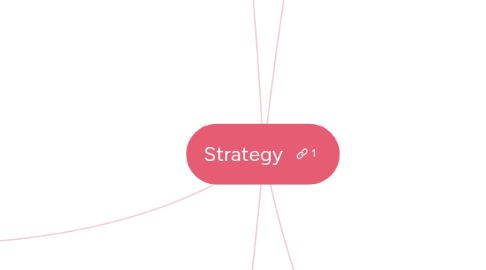
1. Culture
1.1. Core values
1.1.1. Principles
1.2. Work environment
1.2.1. Physical conditions
1.2.2. Social interactions
1.3. Ethics
1.4. Goals
2. Competition
2.1. Competitive advantage
2.1.1. Features of the product
2.1.1.1. Porter's generic strategies
2.1.1.1.1. Focus strategy
2.1.1.1.2. Cost leadership
2.1.1.1.3. Differentiation strategy
2.1.2. Sources
2.1.2.1. Brand and marketing
2.1.2.2. Post-sale care
2.1.2.3. Finance
2.1.2.4. HR management
2.1.2.5. Technology
2.1.2.6. Production
2.1.2.7. Management
2.1.3. Strategic flexibility
2.2. Red ocean strategy
2.2.1. Existing market
2.2.2. Big competition
2.3. Blue ocean strategy
2.3.1. New market/niche
2.3.2. Small competition
3. Levels of strategy
3.1. Corporate
3.2. Business
3.3. Functional
3.3.1. Marketing
3.3.2. Production
3.3.3. Operations
3.3.4. Finances
3.3.5. Human Resources
4. Mission (vision)
4.1. Area of activity
4.2. Mission statement
4.3. Strategic goals
4.4. Strategic advantage
4.4.1. Core competencies
4.4.1.1. Service offering
4.4.1.2. Technology expertise
4.4.1.3. Marketplace niche
4.4.1.4. Particular business acumen
4.4.2. External resources
4.5. Functional operating programs
4.5.1. Tasks
4.5.2. Budgets
4.5.3. Schedule
4.5.4. Tasks = authority = responsibility
4.6. Objectives
4.6.1. KPI
4.6.1.1. Input
4.6.1.2. Output
4.6.1.3. Activity
4.6.1.4. Mechanism
4.6.1.5. Control
4.6.1.6. Time
4.7. Vision statement
5. Strategy analysis
5.1. External analysis
5.1.1. Porter’s five forces
5.1.1.1. Threats of new entrants
5.1.1.2. Threats of substitutes
5.1.1.3. Power of customer
5.1.1.4. Power of suppliers
5.1.1.5. Competitive rivalry
5.1.2. PESTL
5.1.2.1. Political factors
5.1.2.2. Economical factors
5.1.2.3. Social factors
5.1.2.4. Technological factors
5.1.2.5. Legal factors
5.1.2.6. Environmental factors
5.2. Internal analysis
5.2.1. SWOT
5.2.1.1. Strength
5.2.1.2. Weaknesses
5.2.1.3. Opportunities
5.2.1.4. Treats
5.3. Benchmarking
5.3.1. Internal
5.3.2. External
